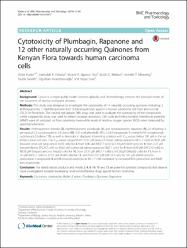| dc.contributor.author | Kuete, Victor | |
| dc.contributor.author | Omosa, Leonidah K. | |
| dc.contributor.author | Tala, Viviane R. Sipowo | |
| dc.contributor.author | Midiwo, Jacob O. | |
| dc.contributor.author | Mbaveng, Armelle T. | |
| dc.contributor.author | Swaleh, Sauda | |
| dc.contributor.author | Sivas, Hülya | |
| dc.date.accessioned | 2019-10-20T08:00:24Z | |
| dc.date.available | 2019-10-20T08:00:24Z | |
| dc.date.issued | 2016 | |
| dc.identifier.issn | 2050-6511 | |
| dc.identifier.uri | https://dx.doi.org/10.1186/s40360-016-0104-7 | |
| dc.identifier.uri | https://hdl.handle.net/11421/16062 | |
| dc.description | WOS: 000390179100001 | en_US |
| dc.description | PubMed ID: 27998305 | en_US |
| dc.description.abstract | Background: Cancer is a major public health concern globally and chemotherapy remains the principal mode of the treatment of various malignant diseases. Methods: This study was designed to investigate the cytotoxicity of 14 naturally occurring quinones including; 3 anthraquinones, 1 naphthoquinone and 10 benzoquinones against 6 human carcinoma cell lines and normal CRL2120 fibroblasts. The neutral red uptake (NR) assay was used to evaluate the cytotoxicity of the compounds, whilst caspase-Glo assay was used to detect caspases activation. Cell cycle and mitochondrial membrane potential (MMP) were all analyzed via flow cytometry meanwhile levels of reactive oxygen species (ROS) were measured by spectrophotometry. Results: Anthraquinone: emodin (2), naphthoquinone: plumbagin (4), and benzoquinones: rapanone (9), 2,5-dihydroxy-3pentadecyl- 2,5-cyclohexadiene-1,4-dione (10), 5-O-methylembelin (11), 1,2,4,5-tetraacetate-3-methyl-6-(14-nonadecenyl)cyclohexadi- 2,5-diene (13), as well as doxorubicin displayed interesting activities with IC50 values below 100 mu M in the six tested cancer cell lines. The IC50 values ranged from 37.57 mu M (towards breast adenocarcinoma MCF-7 cells) to 99.31 mu M (towards small cell lung cancer A549 cells) for 2, from 0.06 mu M (MCF-7 cells) to 1.14 mu M (A549 cells) for 4, from 2.27 mu M (mesothelioma SPC212 cells) to 46.62 mu M (colorectal adenocarcinoma DLD-1 cells) for 9, from 8.39 mu M (SPC212 cells) to 48.35 mu M (hepatocarinoma HepG2 cells) for 10, from 22.57 mu M (MCF-7 cells) to 61.28 mu M (HepG2 cells) for 11, from 9. 25 mu M (MCF-7 cells) to 47.53 mu M (A549 cells) for 13, and from 0.07 mu M (SPC212 cells) to 1.01 mu M (A549 cells) for doxorubicin. Compounds 4 and 9 induced apoptosis in MCF-7 cells mediated by increased ROS production and MMP loss, respectively. Conclusion: The tested natural products and mostly 2, 4, 9, 10, 11 and 13 are potential cytotoxic compounds that deserve more investigations towards developing novel antiproliferative drugs against human carcinoma. | en_US |
| dc.description.sponsorship | Scientific and Technological Research Counsel of Turkey (TUBITAK); Scientific Research Projects Commission of Anadolu University, Eskisehir, Turkey [1507 F563]; International Science Programme, Uppsala University, Sweden [(ISP)-KEN-02] | en_US |
| dc.description.sponsorship | The study was funded by the Scientific and Technological Research Counsel of Turkey (TUBITAK) and to Scientific Research Projects Commission of Anadolu University, Eskisehir, Turkey (funding grant 1507 F563). A grant for part of this work was also provided by International Science Programme, Uppsala University, Sweden (ISP)-KEN-02 project. | en_US |
| dc.language.iso | eng | en_US |
| dc.publisher | Bmc | en_US |
| dc.relation.isversionof | 10.1186/s40360-016-0104-7 | en_US |
| dc.rights | info:eu-repo/semantics/openAccess | en_US |
| dc.subject | Carcinoma | en_US |
| dc.subject | Cytotoxicity | en_US |
| dc.subject | Mode Of Action | en_US |
| dc.subject | Plumbagin | en_US |
| dc.subject | Quinones | en_US |
| dc.subject | Rapanone | en_US |
| dc.title | Cytotoxicity of Plumbagin, Rapanone and 12 other naturally occurring Quinones from Kenyan Flora towards human carcinoma cells | en_US |
| dc.type | article | en_US |
| dc.relation.journal | Bmc Pharmacology & Toxicology | en_US |
| dc.contributor.department | Anadolu Üniversitesi, Fen Fakültesi, Biyoloji Bölümü | en_US |
| dc.identifier.volume | 17 | en_US |
| dc.relation.publicationcategory | Makale - Uluslararası Hakemli Dergi - Kurum Öğretim Elemanı | en_US |
| dc.contributor.institutionauthor | Sivas, Hülya | |


















